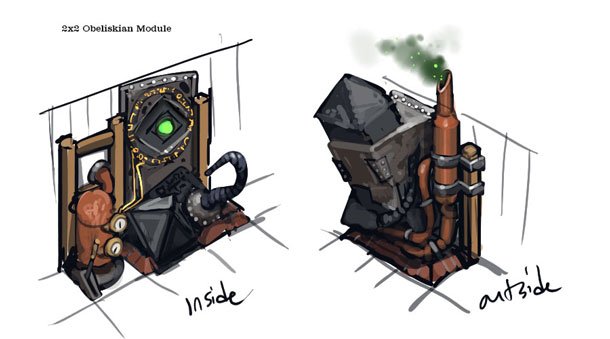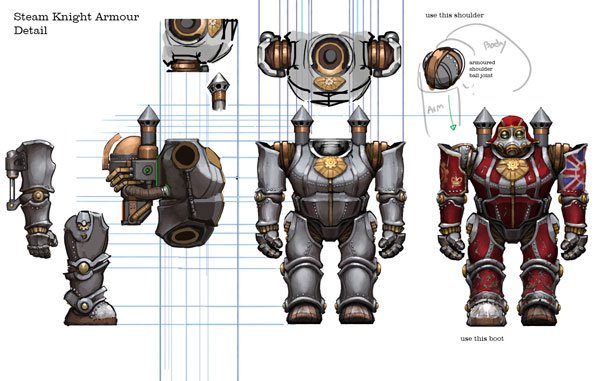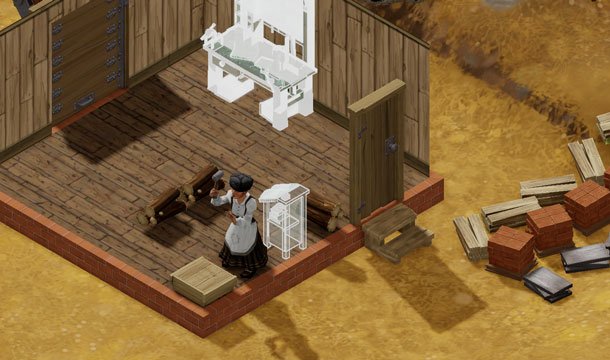Clockwork Empires hands-on: Life and death on the frontier
Construction and Cthulhu
Grimness and dark humor don't fully permeate Clockwork--its sunny world and charmingly rounded isometric art disguise its horror elements. When I sit down to build my first structure, I click-drag on the isometric grid to set the dimensions of the building (which can be modified in the future), then I drop in the objects that will live inside. The camera moves comfortably on WASD. Like The Sims, there's tiny pleasure in deciding where a window or light fixture goes, or in deciding to hang a painting over a power saw in my carpentry workshop, hoping to make a workman's log-cutting less mundane. These micro-decisions aren't simply aesthetic, either—how many doors you attach to a building, or where they're placed, has an impact on how well characters pathfind.
For creating specialized structures, Clockwork's building system has a similar logic as Prison Architect's: you have to plug in certain required modules in order to make a building become a kitchen. An ore refinery needs a kiln, crucible, and a lectern, for supervision. A carpentry workshop needs a power saw. Lovecraft finds its way into this element of the game, too: there will be Eldritch modules. They aren't in Clockwork yet, but Jacobsen explains that these dark devices might “turbocharge” existing structures to increase their output or eliminate the need for an building material, but likely with some consequence to the sanity of your citizens. Jacobsen gives an example: “A player can find an eldritch module in some ancient ruins which constructs whole, living chickens out of logs. Of course, chickens created by such a module would possess a great deal of madness and anyone who ate said chicken would increase in madness as well.” I'm shown concept art for an “Obeliskian module,” a haunting contraption with green smoke leaking out of bronze pipes that seems to have one of Clockwork's ink-black, tentacled Obeliskian creatures installed directly into it.

There are also megaprojects: risky, time-consuming, cursed super-structures “built to exploit 'knowledge which was not meant to be known,'” as Jacobsen describes. “They are industrial monuments to the scientific hubris of The Empire, an attempt to draw on power from the alien forces that hide in the dark corners of the world.” They include the Invisible Gateway, a portal that leads to “The Invisible Geometries” that you can send naturalists through, with unknown results. Or you might find a deactivated obeliskian creature, choose to reactivate it, and create a Living Mine that produces loads of ore, but must regularly be fed meat. Jacobsen warns, “If meat is not made available at a sufficient rate, it'll find its own meat to feed on.”
If all goes according to plan, Clockwork's weirdness will be in service of memorable, hilarious, and tragic frontier stories. Your colony's citizens are flawed characters, defined by their traits—permanent or temporary descriptions like “hungover,” “adaptable,” “bee fancier,” or “professionalism,” which are listed in each character's info panel. True to the pseudo-scientific thinking of the Victorian era, new arrivals to your colony will have to have their skulls examined by a phrenologist, a middle-class worker, before their traits are known.

Gaslamp doesn't want traits to be simply flavor text, but fully-functional elements of identity that influence behavior. A Communist character, Jacobsen says, has “positive feelings toward the lower class and fellow communists and negative feelings toward Monarchists and upper class characters. The results of these negative feelings should come out through the simulation—a Communist would much more easily become angry at, and get into a fist-fight with, an aristocrat Monarchist.” Communists might also organize strikes in work parties, or start an armed rebellion, if they're upset enough.
There seem to be plenty of conventional and otherworldly things that'll kill your citizens outright in Clockwork, but Gaslamp's design philosophy is that problems like a worker uprising shouldn't necessarily all be “fires” that have to be put out, but interesting events that spark more interesting stories. As Jacobsen puts it, “The most obvious video game outcome from meeting a monster is that a character gets killed—but that's not an interesting story because that's the end of the story! So we say, what if the character doesn't die, but comes back to your colony changed .” Kidnapping will be a mechanic in Clockwork: a settler might be plucked from their bed by fishpeople, return several days later, and then spend their nights staring out at the ocean instead of restfully in bed. “Invisible Geometers might kidnap two people and could swap their heads, leading to poor reactions from former friends and family, resulting in some mix of comedy and tragedy,” says Jacobsen. Characters who experience these kinds of involuntary body-swaps would have greatly increased madness, a discrete value measured for all citizens.

Gaslamp's goal of domesticating Dwarf Fortress makes Clockwork Empires one of the most interesting games in development today. The potential for moddability and the promise of multiplayer, which is currently in a testing state within the studio, could give Clockwork a long lifespan. What's most appealing to me about the game is Gaslamp's intention to replicate the Dwarf Fortress-like experience of failure not simply being a disappointment, but something that triggers “narrative successes.” As Jacobsen told me in 2012, “When you were a kid and you built with Legos, eventually you build something up and you knock it down because there's nothing else to do. Dwarf Fortress approached that in a really sophisticated way: it constantly is sort of knocking down your Legos, and you are constantly having to try and one-up your design to make it a little bit better, a little more robust.”
The biggest gaming news, reviews and hardware deals
Keep up to date with the most important stories and the best deals, as picked by the PC Gamer team.
Gaslamp hopes to release an early version of Clockwork Empires sometime this spring. Read our long interview with Gaslamp Games .

Evan's a hardcore FPS enthusiast who joined PC Gamer in 2008. After an era spent publishing reviews, news, and cover features, he now oversees editorial operations for PC Gamer worldwide, including setting policy, training, and editing stories written by the wider team. His most-played FPSes are CS:GO, Team Fortress 2, Team Fortress Classic, Rainbow Six Siege, and Arma 2. His first multiplayer FPS was Quake 2, played on serial LAN in his uncle's basement, the ideal conditions for instilling a lifelong fondness for fragging. Evan also leads production of the PC Gaming Show, the annual E3 showcase event dedicated to PC gaming.

